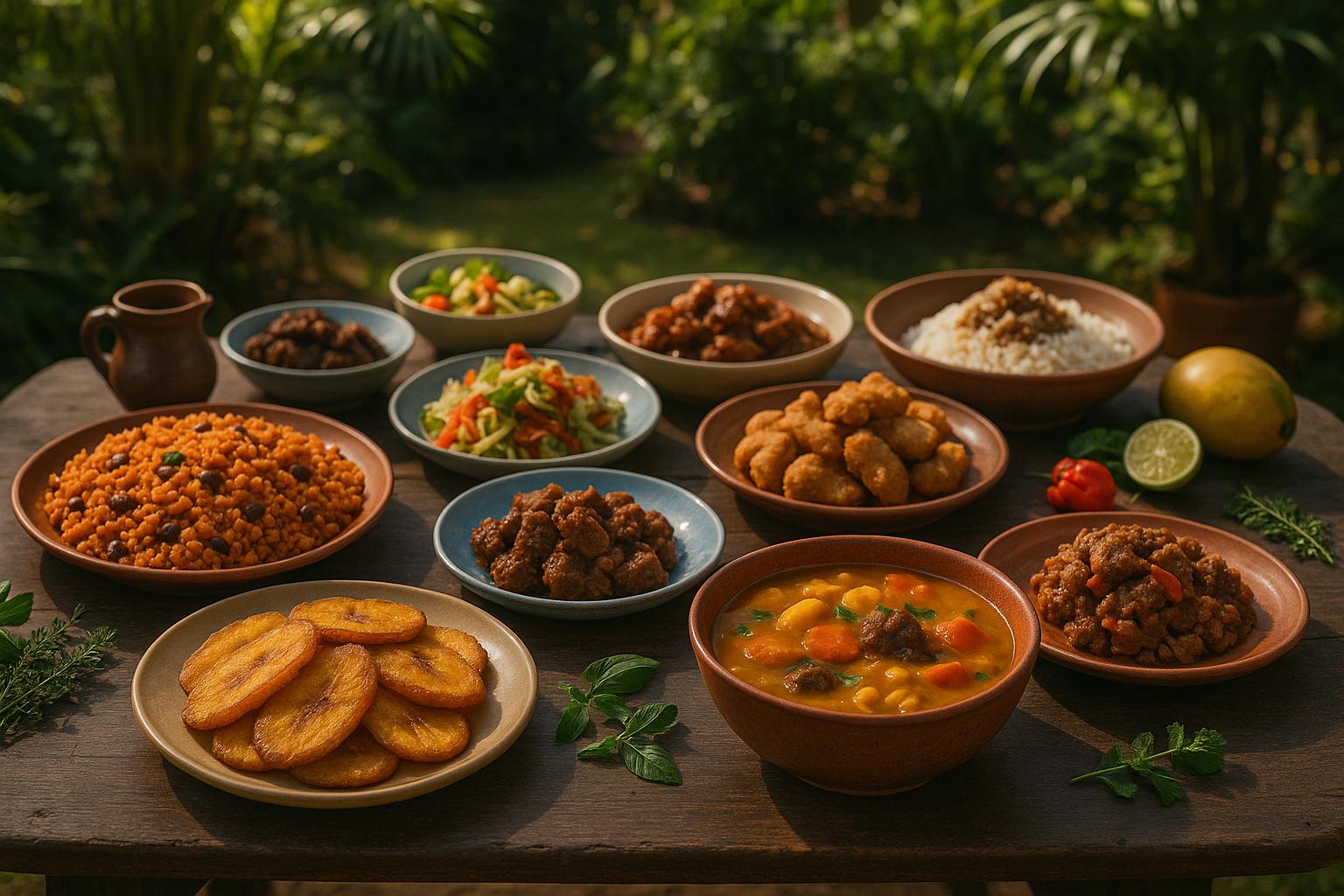Bouyon is a hearty Haitian soup made with meats, root vegetables, dumplings, and greens. It's a comforting dish perfect for cold days or when you're feeling under the weather. Here's what you need to know to make it:
- Main Ingredients: Beef, goat, chicken, or fish (2–3 lbs); root vegetables like yams, potatoes, and plantains; leafy greens (spinach or watercress); dumplings ("boys"); and seasonings like epis (Haitian spice blend), onions, garlic, and scotch bonnet peppers.
- Key Steps: Marinate the meat with lime juice and spices, chop vegetables, make dumplings from flour and water, and simmer everything together in a large pot until tender.
- Tools: A large stockpot or Dutch oven, sharp knife, cutting board, and mixing bowls.
- Customizations: Swap proteins (e.g., pork or seafood), adjust spices, or make a vegan version with jackfruit or mushrooms.
Bouyon is versatile, easy to adapt, and a delicious way to bring the flavors of Haiti to your kitchen. Ready to get started? Keep reading for the full recipe and step-by-step instructions.
THE BEST BOUILLON/BOUYON VEGETABLE STEW GIVES STRENGTH VERY NUTRITIOUS HAITIAN DISH
Ingredients and Tools You'll Need
Making bouyon at home brings the flavors of the Caribbean right into your kitchen. The good news? Most of the ingredients and tools you’ll need are easy to find in the U.S., and there are plenty of substitutes for those that might be harder to track down.
Main Ingredients
The backbone of a great bouyon is the protein. Traditionally, beef is the go-to, but chicken, goat, or pork are fantastic alternatives. Aim for 2–3 lbs of meat, cut into chunks. Cuts with some fat or connective tissue - like chuck roast, short ribs, or bone-in chicken thighs - are ideal for adding richness.
Root vegetables are what give bouyon its hearty, comforting texture. Traditional choices include malanga (which packs 7 grams of fiber per 2/3 cup serving [4]), yellow yam, cassava, and taro. You’ll also need plantains, sweet potatoes, and regular potatoes. Plan for about 4–5 lbs of mixed root vegetables to get the perfect balance.
Leafy greens not only brighten the dish but also add a nutritional punch. Watercress is a classic choice, but spinach works just as well. Other options include shredded kale, collards, or Swiss chard [1]. About 2–3 cups of chopped greens should do the trick.
The flavor of bouyon comes alive with aromatics and seasonings. You’ll need onions, garlic, and epis - a Haitian seasoning blend made with herbs and aromatics [1][3]. If you can’t find pre-made epis, it’s easy to make your own by blending parsley, cilantro, bell peppers, garlic, and onions.
And don’t forget the dumplings! Known as "boys" in Haitian cuisine, these flour-based dumplings are a must for authentic bouyon [2][3]. You’ll need about 2 cups of all-purpose flour, plus water and salt.
Optional Ingredients and Substitutes
Want to take your bouyon up a notch? Tomato paste is sometimes added for a deeper broth color [4][3]. Other popular add-ins include green beans, carrots, and yucca, depending on personal or family preferences.
If you can’t find traditional Caribbean root vegetables, don’t stress. Regular potatoes like russet or Yukon Gold work beautifully, as do Japanese sweet potatoes [1]. The key is using a variety of starchy vegetables to achieve that signature thick, hearty consistency.
For greens, feel free to get creative. Spinach, kale, collards, or Swiss chard are all great substitutes or additions to watercress [1]. When swapping fresh herbs for dried, remember to use larger quantities of the fresh ones for the best flavor.
Kitchen Equipment
You don’t need anything fancy to make bouyon, but having the right tools can make the process much easier. A large stockpot or Dutch oven is a must - go for one that’s at least 6–8 quarts to fit everything comfortably. Heavy pots, like those made of cast iron, are especially handy because they distribute heat evenly and help prevent burning [5].
A sharp knife and a sturdy cutting board are essential, as you’ll be chopping a lot of vegetables. Cutting them into larger chunks helps them hold their shape during the long cooking process [5].
Other helpful tools include mixing bowls for marinating the meat and preparing the dumplings, along with measuring cups and spoons to get your seasoning just right. Tongs are useful for handling hot ingredients safely, and while a kitchen scale isn’t mandatory, it can help with precise measurements.
If you’re making your own epis or want to puree some vegetables for a thicker broth, a blender will come in handy. And don’t forget a wooden spoon or spatula for stirring as your bouyon simmers to perfection. Once everything is prepped, you’re ready to move on to the cooking process!
How to Make Bouyon Step by Step
With all your ingredients prepped, it’s time to start making bouyon. While the process might seem a bit detailed, breaking it into steps makes it much easier to tackle.
Marinating the Meat
The key to a flavorful bouyon lies in well-marinated meat. Start by cutting 2–3 pounds of beef into evenly sized cubes, trimming any excess fat, and patting the pieces dry.
To create the marinade, mix together 4 tablespoons of epis, 1/2 teaspoon each of seasoning salt and Adobo, one dissolved Maggi cube, the juice of 2–3 limes, 1 diced onion, and 3–5 crushed garlic cloves. This forms a flavorful paste. Coat the meat thoroughly with the mixture and refrigerate it for at least 30 minutes - or, for deeper flavor, let it sit overnight. The lime juice not only adds a tangy kick but also helps tenderize the meat.
While the meat marinates, move on to preparing the vegetables and dumplings.
Preparing Vegetables and Dumplings
For the vegetables, peel and chop root varieties like potatoes, malanga, cassava, and sweet potatoes into chunks about 1–2 inches in size. Slice carrots into even pieces for consistent cooking.
Wash your leafy greens - watercress or spinach work well - and roughly chop them. For the plantains, peel them and cut into 1/2-inch thick rounds.
Now, let’s make the dumplings, often called "boys." Combine 2 cups of all-purpose flour with 1/2 teaspoon of salt. Gradually add water, mixing until a cohesive dough forms. Knead it briefly, let it rest for about 10 minutes, then divide the dough into small, walnut-sized portions.
With everything prepped, you’re ready to cook the soup.
Cooking the Soup
Start by heating a large stockpot over medium-high heat. Add the marinated meat along with the marinade and brown it for 10–15 minutes. If the pot begins to dry out, deglaze with a splash of water or broth.
Once the meat is browned, pour in enough water to cover it by about 2 inches - this usually means adding 8–10 cups. Bring the pot to a boil, then lower the heat to medium-low, letting it simmer gently for 45 minutes to an hour, or until the meat begins to tenderize.
Now, it’s time to add the vegetables. Begin with the firmer ones like carrots and potatoes, as they take longer to cook. Let these simmer for about 15 minutes before adding the softer root vegetables, such as malanga, cassava, and sweet potatoes.
After 30 minutes of simmering, drop in the dumplings and let them cook for 20–30 minutes until they’re done.
In the final 10 minutes, add the plantains and any remaining tender vegetables. During the last 5 minutes, stir in your leafy greens. These will wilt quickly while keeping their vibrant color and nutrients intact.
Finish the soup by seasoning with salt, pepper, and a squeeze of lime juice. The result should be a hearty dish with tender meat, perfectly cooked vegetables, and a slightly thickened broth. It’s this rich, satisfying consistency that makes bouyon such a beloved comfort food.
Recipe Variations and Modifications
Bouyon is incredibly versatile, making it easy to adjust for different diets, seasonal ingredients, or personal preferences. Let’s look at how you can customize this comforting dish with various proteins, vegetables, and dietary tweaks.
Different Proteins and Vegetables
While beef is the classic choice for bouyon, it’s not the only option. You can easily swap it out for chicken, pork, or goat, using the same marinating and cooking techniques [8].
For seafood enthusiasts, smoked herring (aranso) brings a smoky depth to the dish when paired with the root vegetables [8].
If you’re going plant-based, there are plenty of satisfying alternatives. Pulled jackfruit, when rinsed, drained, and sautéed with garlic and salt, can mimic the texture of shredded beef [7]. Thick slices of king oyster or portobello mushrooms sautéed with the same seasonings provide a hearty, meaty bite [7]. Tofu, beans, or even mock beef products also work well when marinated with the traditional spice blend [5][8].
When it comes to vegetables, you can get creative. If malanga isn’t available, taro makes an excellent substitute [7]. Sweet corn and yam can add unique textures and flavors to the mix [6].
Leafy greens are another area where you can experiment. While watercress is traditional, spinach, shredded kale, collards, or Swiss chard make great alternatives [1]. Just note that sturdier greens like kale or collards may need a few extra minutes of simmering compared to more delicate options like watercress or spinach [1].
Dietary Adjustments
Bouyon is easy to adapt for various dietary needs. For a vegan version, focus on creating rich umami flavors. Nutritional yeast is a great addition, as vegan cooking expert Kathy Hester explains:
Nutritional yeast gives an umami punch, and though it seems counter-intuitive, it can add a chicken flavor to your vegan recipes [10].
Instead of using a Maggi cube, you can make your own bouillon powder with nutritional yeast, dried herbs, and spices. Shane Martin highlights its versatility:
This Vegetable Bouillon Powder is perfect for adding flavor to soups, stews, and other dishes. It's easy, fast, and a great substitute for vegetable broth [9].
Homemade bouillon can be stored in an airtight container for up to six months [10].
For those who prefer less spice, reduce the amount of hot peppers. If you like more heat, feel free to add extra. A squeeze of lime at the end can bring balance to the flavors.
Finally, you can adjust the portions to suit your preferences. Double the vegetables or dumplings for a heartier bowl - it’s all about making the dish your own.
sbb-itb-80c33ff
Serving and Storage Tips
How to Serve Bouyon
Bouyon is best enjoyed hot, bringing a sense of warmth and togetherness to the table. To capture its hearty essence, serve it in deep bowls, ensuring plenty of room for the chunky vegetables, tender meat, and flavorful broth. A sprinkle of parsley on top adds a touch of freshness, while a side of crusty bread completes the experience - perfect for soaking up every last drop of the savory liquid.
Storing and Reheating
One of bouyon's charms is how its flavors deepen after a day in the fridge. Leftovers can be stored for 4 to 5 days if handled properly. To keep it safe, cool the soup quickly, transfer it into shallow, airtight containers, and refrigerate within two hours, ensuring it reaches 40°F (4°C). Don’t forget to label the containers with the date for easy tracking.
When reheating, you can use either the microwave or stovetop. For the microwave, heat in a microwave-safe bowl for 2–3 minutes, stirring halfway through. On the stovetop, warm it over medium-low heat for 5–10 minutes, adding a bit of hot water or broth if the soup has thickened too much. Always make sure the soup reaches 165°F (74°C) for safe consumption. If the reheated soup feels a little watery, let it simmer uncovered for a few minutes to concentrate the flavors.
Planning to save some for later? Follow these freezing instructions to keep it fresh.
Freezing for Later
Bouyon freezes beautifully, holding its quality for up to 3 to 4 months. If your recipe includes dumplings, it’s a good idea to store them separately to avoid them turning mushy during freezing and thawing.
Divide the soup into meal-sized portions before freezing - this way, you only thaw what you need. Use airtight containers or freezer bags, and make sure to label them with the storage date. When you’re ready to enjoy it again, thaw the bouyon in the refrigerator overnight or use a cold water bath for a quicker option. Reheat using the methods mentioned earlier, ensuring it reaches 165°F (74°C) before serving.
Conclusion
Bouyon brings together marinated protein, fresh vegetables, and dumplings, all simmered into a hearty, flavorful soup. This straightforward recipe showcases how bouyon can fit seamlessly into any home kitchen.
Its versatility and comforting nature pay tribute to Haiti's rich culinary traditions. Haitian cook Suzon perfectly captures its essence:
"Bouyon is such a versatile soup. The protein can be any kind of your choosing and there are plenty of various vegetables, especially root vegetables. What really makes it Bouyon is the boy. You can't have Bouyon without the boy."
Whether you prefer beef, goat, pork, chicken, or even a vegetarian twist, bouyon adjusts beautifully to your tastes while staying true to its roots.
Start with familiar vegetables like potatoes and carrots, and then branch out to traditional ingredients such as malanga or yucca. Bouyon is more than just a meal - it’s a connection to Haiti’s vibrant culinary heritage, echoing the spirited phrase, "Bagay sa ap ba-ou fos!!" (This stuff will give you strength!).
Explore more Haitian recipes and cultural traditions at HaitianFoods.org.
FAQs
Can I use a slow cooker to make bouyon instead of a stockpot or Dutch oven?
Yes, you can definitely prepare bouyon in a slow cooker! This approach is not just convenient - it also gives the flavors plenty of time to meld together while ensuring the meat turns out tender and delicious. It's a fantastic option if you're looking for a low-maintenance way to enjoy this hearty Haitian soup.
To make bouyon in your slow cooker, simply place all the ingredients into the pot, set it to low or high based on how much time you have, and let it simmer until the vegetables are soft and the meat is perfectly cooked. For the best results, give it an occasional stir to ensure everything cooks evenly.
How can I make sure the dumplings in my bouyon come out perfect every time?
Tips for Perfect Dumplings in Your Bouyon
Making dumplings that are tender, fluffy, and downright delicious takes a bit of know-how. Here’s how to get it right every time:
- Nail the dough consistency: Start by mixing flour, baking powder, and a pinch of salt. Gradually add lukewarm water until the dough is soft but not sticky. Let it rest for 15–30 minutes before shaping - it makes all the difference.
- Shape matters: For faster cooking, roll the dough into stick-like shapes. Prefer the round ones? That works too, but remember they’ll take a little longer to cook.
- Simmer, don’t boil: Drop the dumplings into gently simmering soup. This keeps them intact and ensures they cook evenly.
- Resist the urge to peek: Keep the lid on while the dumplings cook. The trapped steam is what gives them that light, fluffy texture.
- Check for doneness: After about 15–20 minutes, cut one open to make sure it’s fully cooked inside.
Follow these steps, and you’ll have dumplings that perfectly complement your bouyon every single time!
How can I modify a bouyon recipe for dietary needs like gluten-free or low-sodium options?
To tailor a bouyon recipe to meet specific dietary needs, consider these simple tweaks:
- Gluten-Free Options: Many store-bought bouillon cubes include gluten, so look for certified gluten-free alternatives. Better yet, create your own by blending dried herbs, spices, and nutritional yeast. Always double-check product labels to ensure they meet gluten-free standards.
- Lowering Sodium: Pre-made bouillon often packs a lot of sodium. Opt for a low-sodium version or cut back on added salt in your recipe. For full control over flavor and salt levels, try making a homemade bouillon base using fresh herbs, spices, and water.
These adjustments allow you to enjoy a flavorful bouyon while accommodating dietary restrictions or preferences.


